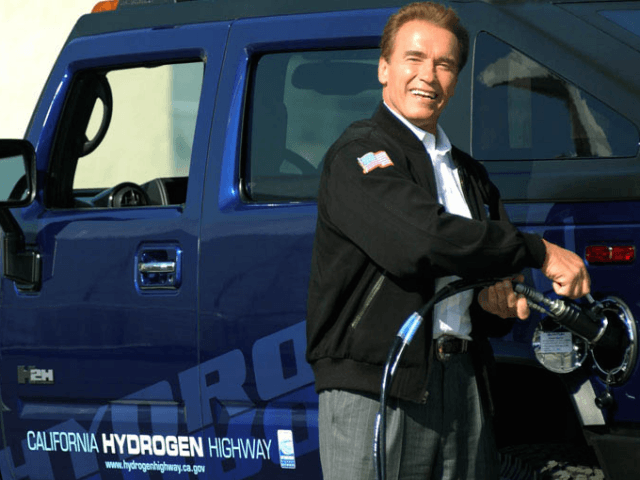The California Energy Commission is honoring ex-Governor Schwarzenegger’s dream by spending another $20 million to build the supposedly non-polluting ‘hydrogen highway’ through most parts of the Golden State.
A high school freshman math class could figure out that the reason no private company has built the road to the “hydrogen economy” is that it is bizarrely wasteful, since it requires about four times the energy input to make hydrogen. When it comes to subsidies, however, nobody in government is very concerned about “running out of other people’s money.”
A decade ago, Schwarzenegger was running around in his hydrogen powered Hummer chatting up the virtues of his dream to build a sustainable “hydrogen highway” from Mexico to Canada, so he would not have to feel so guilty about tooling around in his 6,400 pound monster. A decade later, that dream will not include the Hummer, General Motors killed off the Terminator’s favorite “ride” in 2010.
Hydrogen fuel cell technology is a legitimate energy source that has been around since the 1830s, yet high costs have historically made the technology best suited for Soviet submarines. Fuel efficiency is not a major issue for military applications. Since submarines are vulnerable to detection when surface or “snort” exhaust air, there is a demand for fuel cells as a stealthy, high performance, air-independent propulsion power source that can extend emergency underwater operations and reduce detectability.
But personal vehicles never need any of these attributes. A study by fuel cell expert Ulf Bossel published shortly after Schwarzenegger began touting the ‘hydrogen highway’ calculated the large amount of energy required to isolate hydrogen from natural compounds such as water, natural gas, and biomass. Bossel calculated that after packaging the light gas by compression or liquefaction, and transferring the energy carrier to the user, and converting it to useful electricity, around 25% of the energy is left for practical use.
Bossel commented, “More energy is needed to isolate hydrogen from natural compounds than can ever be recovered from its use.” Making condensed hydrogen as a “new chemical energy carrier” requires four times the electrical input from natural gas, the most efficient and cost competitive electricity source. He observed that the increased use of natural gas would generate more CO2 emissions than a gasoline engine.
None of this has swayed the California Energy Commission, which is in the business of subsidies, not energy efficiencies.
The new $20 million spending tranche will build 26 more hydrogen stations. In May, the Commission allocated nearly $50 million to eight companies to build 28 hydrogen fueling stations—13 in Northern California and 15 in Southern California. The goal is to have 54 hydrogen fueling stations online by November 2015, when hydrogen fuel cell cars become commercially available in California with the introduction of the FCX Clarity from Honda and the Mira from Toyota. Hyundai already leases a limited-run hydrogen fuel cell version of its Tucson SUV.
With more subsidies rolling out, California in the next two years will probably have the 100 stations needed to give a driver of a hydrogen car enough range to travel freely through most parts of the Golden State. The vehicles have a range of about 300 miles on a single fill-up. Energy Commissioner Janea A. Scott said that her goal “is to match the number of stations to the number of cars coming in, and then let the market take over.”
However, Bossel warned: “The advantages of hydrogen praised by journalists (non-toxic, burns to water, abundance of hydrogen in the Universe, etc.) are misleading, because the production of hydrogen depends on the availability of energy and water, both of which are increasingly rare and may become political issues, as much as oil and natural gas are today.”
“There is a lot of money in the field now,” Bossel added. “Huge sums of money were committed too soon, and now even good scientists prostitute themselves to obtain research money for their students or laboratories—otherwise, they risk being fired. But the laws of physics are eternal and cannot be changed with additional research, venture capital or majority votes.”

COMMENTS
Please let us know if you're having issues with commenting.